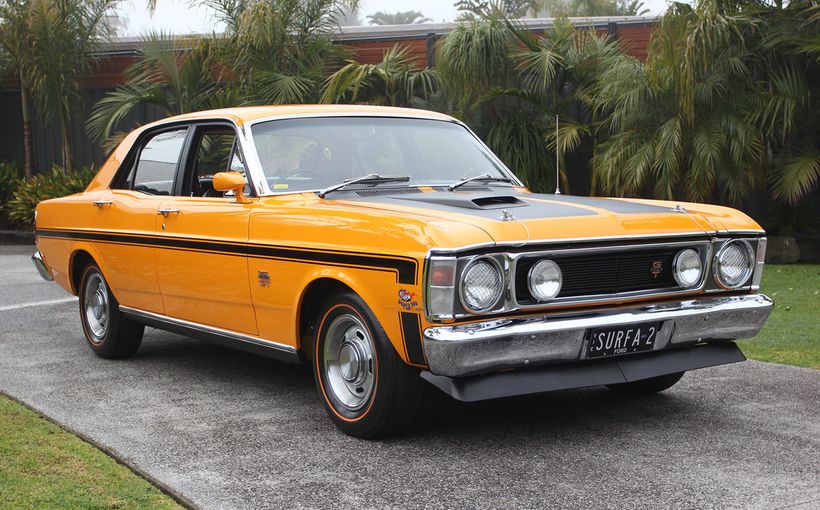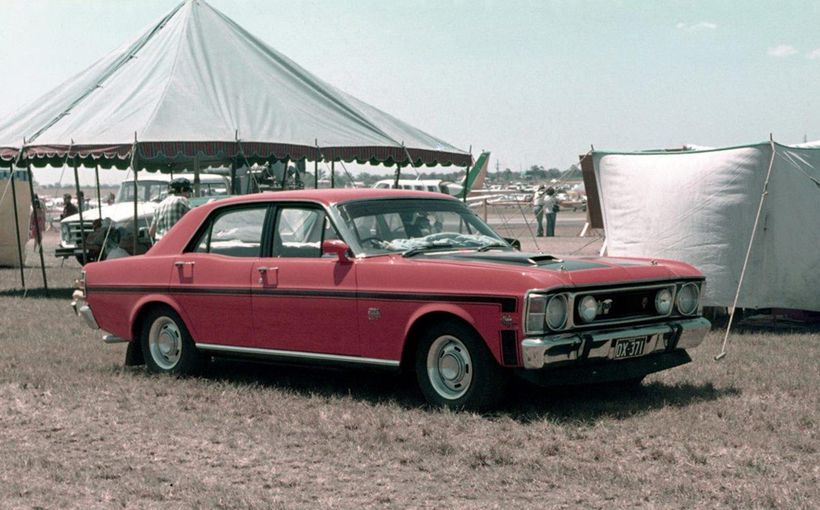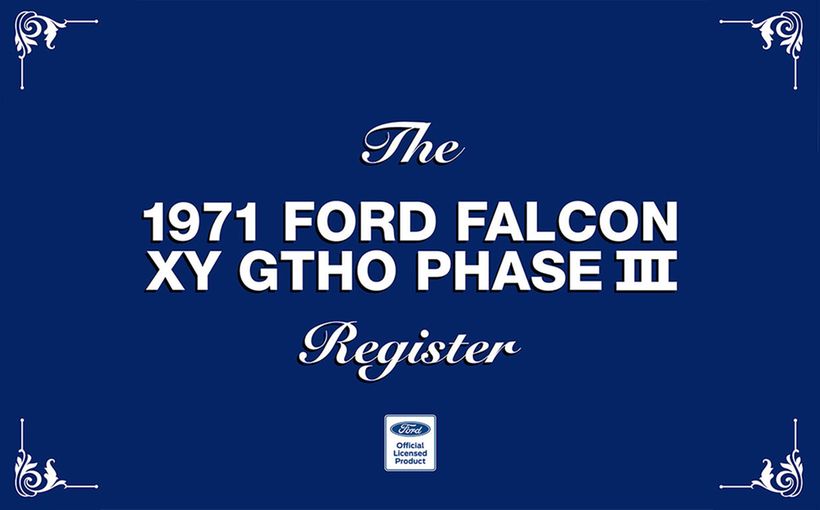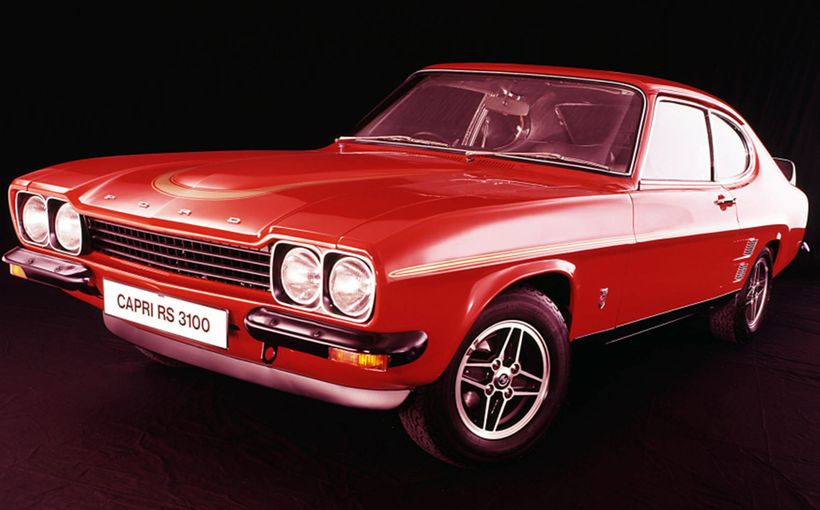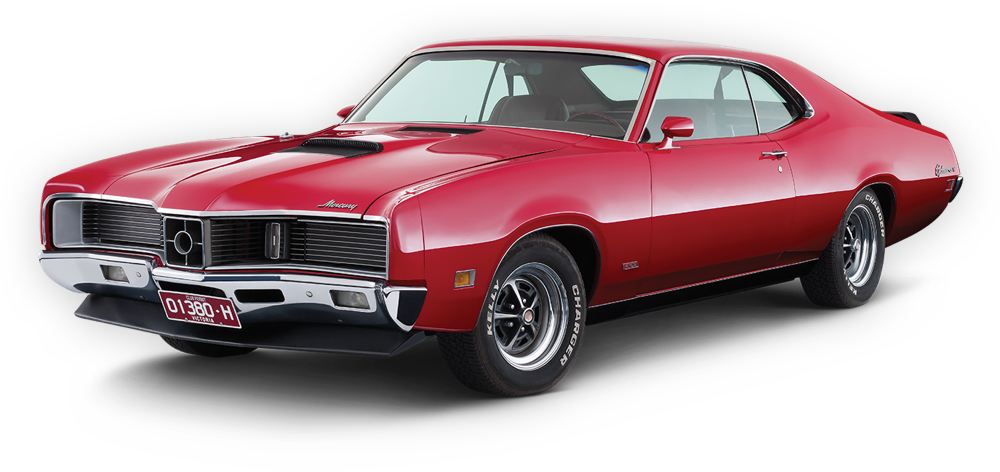
The third and final phase of Ford Australia’s 1970s competition program resulted in a car that has become a legend. The ‘HO’ high performance option available on the XY Falcon GT raised the local performance benchmark to unprecedented heights and produced a trio of major victories which guaranteed the GT-HO Phase Three’s immortal status as the king of Aussie muscle cars.
Those wins included the 1971 Hardie-Ferodo 500 at Bathurst, the endurance-based 1972 Australian Manufacturers Championship and the 1973 Australian Touring Car Championship, largely thanks to the sublime talent of Ford’s number one driver Allan Moffat. They were also achieved across a three-year time frame with each being won in a different year - the last under different rules. It was a testament to the remarkable longevity of the final GT-HO and its performance pedigree.
Released just in time for the annual Bathurst 500 in 1971, the Phase Three was in effect a nose-to-tail refinement of its Bathurst-winning Phase Two predecessor based on the previous XW Falcon GT. The myriad changes have been thoroughly documented over the decades, but worthy of a brief overview here.

The Phase Three was based on the new XY GT, with its handsomely revised front and rear styling, stripes and decals and the iconic ‘shaker’ engine air intake, which protruded through a hole in the bonnet where it breathed cool, dense air for maximum power. It also ‘shook’ with the engine’s movement, hence the famous name.
The most noticeable visual difference in the new GT-HO option, which was only a $250 increase over the $5250 XY GT, was an adjustable blade spoiler on the boot-lid in addition to the full-width front spoiler fitted to previous ‘HOs.
The big 780cfm four-barrel Holley directly beneath the shaker supplied a high octane cocktail of fuel and air to the booming 351cid (5.8 litre) Cleveland V8. This mighty muscle car engine was treated to numerous detailed refinements of intake, exhaust, head gaskets, camshaft, valve-train, bearings, lubrication and cooling, with an emphasis on improved durability at Bathurst.

There was also a wider choice of diff ratios, alternate close-ratio and wide-ratio top loader four-speed gearboxes and revised suspension tuning. Braking performance and durability were also improved which was just as well as it was claimed to be the fastest mass-produced four-door sedan in the world at the time. The highest speed recorded by a Phase Three on Conrod Straight at Bathurst in 1971 was a staggering 151mph (242km/h). The following year the same car nudged that a little higher to 154mph (246km/h).
Although Ford claimed Phase Three engine outputs of only 300bhp (224kW) at the time of release, that has to be seen in the context of trying to calm the nerves of increasingly agitated road safety zealots, insurance companies and governments keen on shutting down these supercars.
Insiders claimed the real output of a stock standard Phase Three was more like 360bhp and as high as 380bhp (285kW) from one of the carefully hand-built ‘QC’ or Quality Control engines. These were made available from the factory for the astonishing price of only $250, built specially for those who planned to race the cars. Clearly the Phase Three’s status as the mightiest of Australian muscle cars is not without merit!

1971 Hardie-Ferodo 500
Surprisingly, the mighty Phase Three did not enjoy a successful debut at the traditional warm-up race before Bathurst - the 1971 Sandown 250 in Melbourne. Only one of the five new GT-HOs entered finished the 250-mile (400km) race, raising questions about reliability at Bathurst.
However, after exhaustive testing of the latest specification of the 351 Cleveland V8, the factory team discovered that their engines had succumbed to severe detonation due to a problem with the ignition advance curve. New distributor settings soon solved the problem.
Bathurst race sponsor Hardie-Ferodo also had to quickly come up with a new brake pad compound at the request of Ford to withstand higher temperatures created by the new GT-HO’s escalating top speeds and closer caliper/disc clearances. Fortunately both of these issues were resolved in time for the Phase Three’s Bathurst appointment only three weeks after Sandown, which had been won by Holden’s LC Torana GTR XU-1.

With 13 of the new GT-HOs entered for the Hardie-Ferodo 500, there was certainly safety in numbers for Ford should the works cars have failed as they did at Sandown. However, during Saturday’s qualifying session, Allan Moffat soon erased any doubts about the car’s capabilities and indeed what he planned to do with it on Sunday. The reigning Bathurst champion unleashed the Phase Three’s awesome might, shattering the lap record by an incredible margin of 13.2 seconds to secure pole position.
No less than 20 cars were under the lap record, with the first seven grid slots filled by the new GT-HOs. Leo Geoghegan was the quickest of Chrysler’s new Hemi six-powered R/T E38 Chargers in eighth and Peter Brock the fastest Torana in tenth spot. Even so, the best any driver other than Moffat could realistically hope for on race day was second place, as Ford’s factory ace blasted into a lead at the first turn he would never relinquish.

The Ford works driver was clearly a man on a mission, pulverising the opposition with his ferocious pace. Not even an empty beer carton, that was swept up onto his car’s grille and blocked airflow to the radiator for numerous laps, could raise the engine temperature or slow him down.
Moffat crossed the finish line one lap clear of the field, smashing the previous race record by more than 20 minutes. The new GT-HOs also finished second and third outright and filled the top eight positions in Class E. It was a devastating performance.

1972 Manufacturers Championship
The GT-HO Phase Three was not supposed to compete in the 1972 Manufacturers Championship (or ‘ManChamp’ for short). If things had gone to plan, it would have been superseded by the new GT-HO Phase Four based on the latest XA Falcon GT sedan released in March 1972.
However the Phase Three raced long beyond its use-by date as a direct result of what became known as the ‘Supercar Scare’ - a politically motivated and media-driven backlash in June 1972 against the three major local car manufacturers and the 160mph ‘supercars’ they were planning to race at Bathurst that year. Each had to build a minimum of 200 road registered examples to be eligible.
‘Bullets on wheels!’ the headlines screamed. Only eight days after the furore erupted, new race rules had been announced for 1973 which eliminated the need to build such cars and governments were threatening to cancel lucrative fleet contracts if the lunacy continued. As a result Holden immediately cancelled its proposed Torana XU-1 V8, Ford nailed the coffin lid closed on the GT-HO Phase Four and Chrysler, which had already released the four-speed Charger R/T E49 before the controversy broke out, immediately shut down the R/T program and withdrew from the sport.

Suddenly, the well planned competition strategies for the Holden and Ford works teams were thrown into disarray. The new Torana V8 and XA GT-HO had been scheduled to face off in the opening round of the five-round 1972 ManChamp at Adelaide in late August, which was then less than eight weeks away.
So Holden and Ford were left with no choice but to revert to their existing mounts - the 202cid (3.3 litre) six cylinder LJ Torana GTR XU-1 and the XY Falcon GT-HO Phase Three - and try to rush through some performance upgrades in readiness for Bathurst in October.
The opening round of the 1972 ManChamp was held at Adelaide International Raceway in late August. The 250-mile (400km) clash attracted numerous Phase Three entries led by Moffat in his 1971 Bathurst winner. The XU-1 Toranas were armed with new 13 x 6-inch Globe Sprintmaster aluminium alloy wheels intended for the stillborn XU-1 V8, but the larger and heavier Falcons were still running their original 14 x 6-inch pressed steel wheels.

As a result the Falcons suffered a series of high-speed blow-outs in practice and the race as the skinny tyres, which were no wider than those on the much smaller and lighter Toranas, literally collapsed under the strain. Moffat paid a heavy price when a front tyre blew and sent him crashing into the concrete wall at high speed, causing terminal damage to his Bathurst-winning ‘HO. The more nimble Toranas on their new lightweight alloy wheels finished a resounding 1-2-3 but Ford had an ace up its sleeve.
The second ManChamp round was the prestigious Sandown 250 in September; another 400km grind on a circuit with long straights that favoured the big V8 Fords. After the Adelaide tyre debacle, Ford rushed through late approval of the Phase Four wheels for the Phase Threes.
These were 15 x 7-inch five-spoke aluminium alloys designed and manufactured by Globe Industries in South Australia under Kevin Drage (who also designed the new Torana alloys). Inspired by the famous Ferrari Daytona wheel, they not only looked great but also provided several performance improvements. They were an inch (25mm) larger in diameter and an inch wider than the Phase Three’s standard 14 x 6-inch pressed steel wheel, allowing a switch to the fatter and lower profile new generation of racing tyres, which would deliver big gains in lap speed and tyre durability.

The Globe wheels also halved the Phase Three’s soaring brake temperatures in racing, from around 850 degrees Celsius to 450 degrees, thanks to vastly improved ventilation and the superior heat dissipation properties of aluminium over steel. The Globes were also much stronger than the old steel wheels, yet with their cast-aluminium construction provided a big reduction in unsprung weight. They were the crucial equaliser Ford needed to address the growing Torana threat.
Moffat, now driving a replacement Phase Three for his badly damaged 1971 Bathurst winner, claimed pole position for the Sandown clash but retired from the race early due to a gearbox problem. Even so, it was a Ford clean-sweep with popular privateer John Goss winning from works driver Fred Gibson and perennial privateer Murray Carter in third. The ManChamp score between Ford and Holden was now one-all.
The Hardie-Ferodo 500 at Bathurst in October was also a ManChamp round for the first time. Moffat again set Mount Panorama alight in qualifying with a scorching pole position time that was three seconds faster than the previous year. With four GT-HOs filling the first four grid positions, it looked like Ford V8 power was again going to overwhelm the opposition.
However, it was raining for the race start on Sunday which allowed the more nimble Toranas to gain the upper hand. Moffat was also beset with numerous problems including a high-speed spin, two time penalties for starting his car during refuelling and disintegrating front brake pads – the result of running too cool due to the wet weather and improved ventilation of the new alloy wheels. Privateer John French steered the highest placed GT-HO to second place behind race winner Brock in his HDT Torana.

With the ManChamp score now 2-1 in Holden’s favour, the gruelling 500-mile (800km) fourth round at Victoria’s Phillip Island and the fifth and final 300-mile (480km) clash at Queensland’s Surfers Paradise Raceway presented Ford with a simple task - win both rounds to win the ManChamp. Stung by its humiliating Bathurst loss, the Ford works team rose to the challenge with Moffat and his mighty GT-HO scoring two emphatic victories over the Toranas to win the series.
Moffat’s perfect score of five pole positions from five rounds and Ford’s three decisive victories at Sandown, Phillip Island and Surfers Paradise proved that the Phase Three with its uprated wheels and tyres was far from a spent force.
Which was just as well because with no XA-based successor ready to take over in 1973 under a new set of rules, the Phase Three would again be denied a long overdue retirement for what would be a memorable encore.

1973 Australian Touring Car Championship
The new rules, which applied from January 1, 1973 were called ‘Production Touring - Group C’ and allowed for limited modifications to be made to a standard, mass produced sedan to make it better suited to racing use. These freedoms included limited upgrades to engines, exhaust systems, suspensions, brakes and electricals, plus increases in wheel and tyre sizes.
In a nutshell, Group C combined the previous Series Production and the ATCC’s Improved Production classes, creating a new breed of touring car which could compete for both the ATCC and the Manufacturers Championship including Bathurst.
Fans expecting Ford to front with the latest XA GT hardtops were to be disappointed. The XA Falcon’s race development program had been frozen when the Supercar Scare erupted in June 1972, and the ensuing months of confusion over the new rules had left Ford seriously behind the eight ball at the start of the 1973 season.

On paper, it was clear that the standard XA GT coupe was no match for the ageing but finely honed Phase Three. So for the 1973 ATCC campaign the Ford works team had no choice but to modify its existing cars to take advantage of the new Group C freedoms, whilst also working hard behind the scenes to develop the XA GT hardtop in readiness for the ManChamp title later in the year. Even so, privateer John Goss defied the factory’s wishes by blazing his own character-building development path with a lone XA GT hardtop.
Ford’s main striker in the 1973 ATCC was Allan Moffat, who was hungry to claim his first national touring car crown which in four seasons had proved elusive in his Boss 302 Trans-Am Mustang. Ford made sure Moffat would have his best chance of finally winning the title by rebuilding his 1972 ManChamp winner to take full advantage of every freedom allowed under the new rules. Ford also backed his 1973 ATCC bid with, for the first time, full works team support.
The end result was one fire-breathing ‘HO. The 351 Cleveland V8, with two bazooka-sized open exhaust pipes poking out the left side, was re-worked to produce more than 400bhp (300kW) at 6800rpm and over 400 ft/lbs of torque at 5200rpm. Suspension and brakes were also upgraded and the widest possible wheels and tyres were squeezed under the standard guards with 15 x 8-inch front and 15 x 9-inch rears wrapped in the latest Goodyear race tyres.

The performance of the HDT Toranas had also enjoyed a substantial boost under the new rules, setting the stage for the ultimate factory war between Ford and Holden. The 1973 ATCC was a close, controversial and exciting pressure-cooker built around Allan Moffat’s GT-HO and Peter Brock’s XU-1. There were other cars competing of course, but in 1973 no one else mattered.
Moffat got his ATCC campaign off to a flying start by winning the first four rounds at Symmons Plains, Calder, Sandown and Perth’s Wanneroo Park. Brock finished second to Moffat at Symmons and Wanneroo but was excluded from the results at Calder and Sandown.
However the Holden star got his campaign back on track after a brilliant win in round five at Surfers Paradise and again at Adelaide, after thieves broke into the Ford team’s workshop on race eve and disappeared into the night aboard Moffat’s ‘HO for a drive through the Adelaide Hills that made national headlines! The car was later found abandoned in the bush, but not before Moffat had been forced to borrow privateer Murray Carter’s Phase Three which he drove to a gritty second place to Brock.

With two rounds remaining, Brock clung to a slim chance of taking the title but would need to win both races and have his Ford rival finish no higher than fourth in each of them. Moffat was reunited with his stolen ‘HO for the penultimate round at Sydney’s Oran Park and after another intense battle with Brock settled for second place to wrap up the championship. However, his second soon became first when Brock’s Torana was excluded post-race for using an illegal inlet manifold.
After such a thrilling season, the final ATCC round at Sydney’s Warwick Farm was an unfitting finale for the Phase Three with Moffat blowing his engine and Brock racing to another victory. With the Ford works team switching over to the new XA GT hardtops for the 1973 ManChamp, the legendary XY GT-HO - the weary but triumphant warrior which had brought Ford and Allan Moffat so much success - had fired its final shot in anger.



